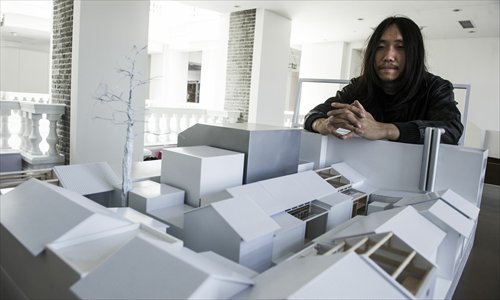

Cao Pu, a Beijing architect, with a model of his planned courtyard hostel. Photo: Li Hao/GT
She has also made a conscious effort to involve local residents in her project, by inviting them to use the old factory as a communal gathering space. Former workers at the electrical relay device factory have visited as well, to share their stories with her. For this year's Beijing Design Week, Re-Up is launching "a series of prototype public facilities for the neighborhood community."
"If you respect your neighbors, not only by talking to them, but also listening to them, sincerely, then you can help them to understand your project," said Lin. "I don't try to emphasize the differences. I try to bridge. And they've been really kind."
So committed is Lin to Re-Up that she sold her London home to fund the project. "Restorations always take a longer period of time, and it is more expensive than tearing everything down and rebuilding," said Lin. "I hope people to find a little bit more about the building, how it was built, its history and everything."
Newcomers not welcome
The municipal government have partnered with the Beijing Design Week to support the efforts of conscientious architects and designers to reinvigorate the old Dashilar neighborhoods. There are no plans at present to demolish and rebuild the entire neighborhood, and residents are not being forcibly evicted to make way for reconstruction.
Some might see this as victory for the local residents. But nothing is being done to give local residents an incentive to stay.
"[The government] has been refurbishing the outsides of houses in the hutong," said a local resident in his 50s who declined to give his name. "But in the winter, we still have no heating."
Over the past year, a number of new shops and businesses have popped up on vacant properties in Dashilar. Although many of these projects have tried to involve local residents and to cause as little intrusion or disruption to their way of life, some of the residents have met the changes with suspicion and hostility.
One month ago, 33-year-old architect Cao Pu, also the guitarist for Beijing-based indie band Queen Sea Big Shark, tried to open a hostel in a siheyuan (traditional courtyard) in the neighborhood.
Such courtyards usually house several families, each family with their own subdivided rooms facing a communal courtyard. Cao wanted to preserve this arrangement, using just one of the rooms in the courtyard space for his hostel.
As someone who was born and raised in Beijing, he was sensitive to the possible disruptions this might cause to the lives of residents who shared the space.
"The hostel would be an intrusion for the neighbors, so I thought about how I could minimize this," said Cao.
His solution was to make the entrance facade into a sliding wall, that would move forwards and backwards to adjust to the number of guests in the hostel. "So if we only had two guests, we could move the wall back to give more space to the courtyard," he explained.
But Cao's plan was met with such strong opposition from one of the residents that he was locked out of the courtyard. He remains optimistic however, and is currently working on implementing his idea in another space, which he intends to present during the Beijing Design Week.
"One of my friends runs a bar in a courtyard. In the beginning, he was not welcome either, but gradually he managed to get on good terms with his neighbors," he said.
Cao sees his project as a way of preserving a disappearing way of life in Beijing. "If the derelict old houses are all demolished, the hutong will disappear," he said.
‘Mini 798‘ captures the imagination in Fangjia Hutong
2014-08-20Area guide: Fangjia Hutong, Beijing
2014-06-24Artist captures Beijing‘s hutong in ink
2014-05-21Copyright ©1999-2018
Chinanews.com. All rights reserved.
Reproduction in whole or in part without permission is prohibited.